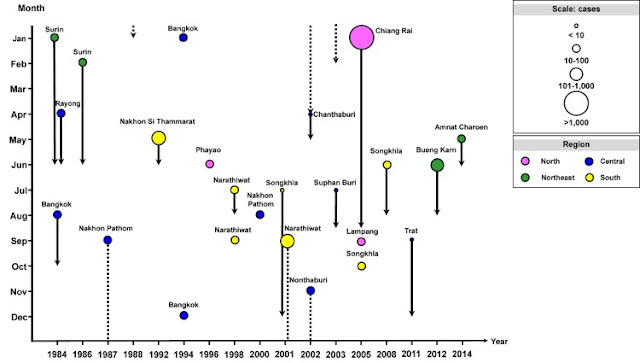Hepatitis A virus (HAV) is
transmitted via the fecal-oral route from contaminated food or water. As part
of the most recent survey of viral hepatitis burden in Thailand, we analyzed
the current seroprevalence of HAV in the country and compared with data dating
back to 1971. From March to October, 2014, a total of 4,260 individuals between
one month and 71 years of age from different geographical regions (North = 961;
Central = 1,125; Northeast = 1,109; South = 1,065) were screened for anti-HAV
IgG antibody using an automated chemiluminescent microparticle immunoassay.
Overall, 34.53% (1,471/4,260) possessed anti-HAV IgG antibody, and the
age-standardized seroprevalence was 48.6%. Seroprevalence rates were 27.3%
(North), 30.8% (Central), 33.8% (Northeast) and 45.8% (South) and were markedly
lower than in the past studies especially among younger age groups. The overall
trend showed an increase in the age by which 50% of the population were
anti-HAV IgG antibody: 4.48 years (1971–1972), 6 (1976), 12.49 (1990), 36.02
(2004) and 42.03 (2014).This suggests that Thailand is transitioning from low
to very low HAV endemicity. Lower prevalence of HAV correlated with improved
healthcare system as measured by decreased infant mortality rate and improved
national economy based on increased GDP per capita. The aging HAV immuno-naïve
population may be rendered susceptible to potential HAV outbreaks similar to
those in industrialized countries and may benefit from targeted vaccination of
high-risk groups.
Below: Map of Thailand and the domicile of study participants
Below: Correlation between infant mortality rate (per 1,000 live births), GDP, and age at which 50% of the population possessed anti-HAV antibody
Below: Documented hepatitis A outbreaks in Thailand from 1984 to 2014
By:
1Center of Excellence in Clinical Virology,
Department of Pediatrics, Faculty of Medicine, Chulalongkorn University, Pathum
Wan, Bangkok, Thailand
2Chumphae Hospital, Chum Phae, Khon Kaen,
Thailand
3Uttaradit Hospital, Mueang Uttaradit,
Uttaradit, Thailand
4Laplae Hospital, Laplae, Uttaradit,
Thailand
5Naresuan University Hospital, Mueang
Phitsanulok, Phitsanulok, Thailand
6Phra Nakhon Si Ayutthaya Hospital, Phra
Nakhon Si Ayutthaya, Thailand
7King Narai Hospital, Mueang Lop Buri, Lop
Buri, Thailand
8Narathiwat Ratchanakarin Hospital, Mueang
Narathiwat, Narathiwat, Thailand
9Trang Hospital, Mueang Trang, Trang,
Thailand
10Bureau of Epidemiology, Department of
Disease Control, Ministry of Public Health, Mueang Nonthaburi, Nonthaburi,
Thailand
Kaohsiung Chang
Gung Memorial Hospital, TAIWAN
More at: https://twitter.com/hiv insight



No comments:
Post a Comment